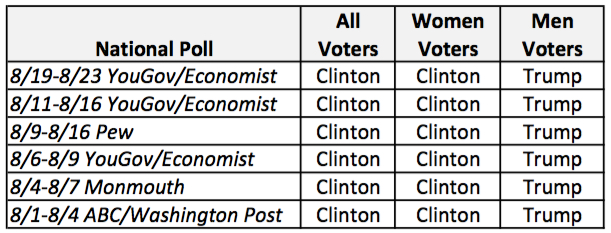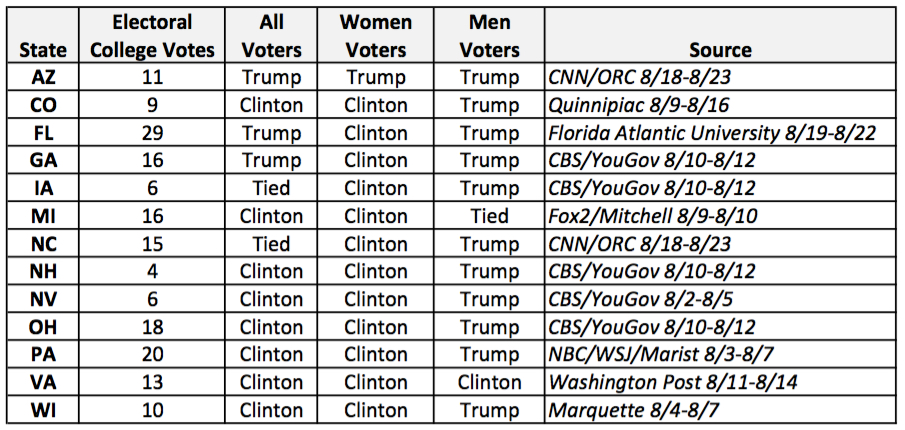Women won the right to vote in presidential elections 96 years ago. What if they hadn’t?
 In April 2015, the Barbara Lee Family Foundation (BLFF) and the Center for American Women and Politics (CAWP) launched Presidential Gender Watch 2016, a project to track, analyze, and illuminate gender dynamics in the 2016 presidential election. With the help of expert scholars and practitioners, Presidential Gender Watch worked for 21 months to further public understanding of how gender influences candidate strategy, voter engagement and expectations, media coverage, and electoral outcomes in campaigns for the nation’s highest executive office. The blog below was written for Presidential Gender Watch 2016, as part of our collective effort to raise questions, suggest answers, and complicate popular discussions about gender’s role in the presidential race.
In April 2015, the Barbara Lee Family Foundation (BLFF) and the Center for American Women and Politics (CAWP) launched Presidential Gender Watch 2016, a project to track, analyze, and illuminate gender dynamics in the 2016 presidential election. With the help of expert scholars and practitioners, Presidential Gender Watch worked for 21 months to further public understanding of how gender influences candidate strategy, voter engagement and expectations, media coverage, and electoral outcomes in campaigns for the nation’s highest executive office. The blog below was written for Presidential Gender Watch 2016, as part of our collective effort to raise questions, suggest answers, and complicate popular discussions about gender’s role in the presidential race.
Today marks Women’s Equality Day, the day the ratification of the 19th amendment was certified. That amendment granted suffrage to women, marking the first time that women could vote in federal elections. Since then, women have emerged as the most reliable voters in American politics, turning out at higher rates than their male counterparts in every election since 1980. The 1980 election also featured a shift in gender preferences at the presidential level that has persisted until today; women have consistently been more likely than men to vote for Democratic nominees, while men have been more likely than women to favor Republican candidates for president. By these measures, the right women won 96 years ago has had a huge impact on American politics, especially in the past four decades.
One way – albeit simplistic- to evaluate how politics would have been different without women’s suffrage is to consider how presidential election results would have differed if only men could vote. An all-male electorate, for example, would have voted for a Republican president in 1996 and 2012, with significant implications for the policy outcomes and political direction of the country.
In 2016, removing women’s political power would also yield a different electoral outlook in the presidential race. Across six four-way national polls conducted this month, Donald Trump leads among men and Hillary Clinton leads among women. If accurate, that means that a popular vote among only men held today would favor Trump as the 45th President of the United States, contrary to the current results which have Clinton winning a plurality of all American voters.

But in presidential contests, it’s the Electoral College vote that matters. So how would Trump fare in key battleground states that could sway electoral college counts if women were excluded from the vote? Results from the most recent polls (where gender crosstabs were reported) in 13 swing states mirror national trends; in all but three states, Hillary Clinton is leading thanks to women’s support. Without women voters, predicted outcomes in six states (CO, NH, NV, OH, PA, WI) would shift from a Clinton to Trump victory. In Georgia and Florida, Trump’s support is strong enough to withstand women’s preference for Clinton in the latest polls, and women’s votes are keeping the races competitive in Iowa and North Carolina. Both men and women favor Clinton in the latest Virginia poll, and this week’s CNN/ORC poll of Arizona voters had Trump edging out Clinton among men and women. In Michigan, male voters are split between the two top presidential contenders; with women’s votes included, Clinton holds an overall lead.

Together, these states represent 160 Electoral College votes, more than enough to sway November’s results. If current poll results stood and women were excluded from voting, Donald Trump would win at least 144 of these votes, pushing him well over the 270-vote threshold to win based on the current measure of safe Democratic and Republican states.
It’s important to note that neither women nor men are a monolithic bloc of voters; just as there are large numbers of men supporting Clinton this year, Trump has earned the support of some women. But the persistent gender differences in presidential polling have become particularly stark in this year’s campaign, reminding us of the difference women make in electoral outcomes.
In a 2013 chapter about the gender gap in voting, Dr. Susan J. Carroll concluded, “It may have taken 60 years to arrive, but the women’s vote that the suffragists anticipated is now clearly evident and has been influencing the dynamics of presidential elections for more than three decades.” 2016 appears to be no exception.


